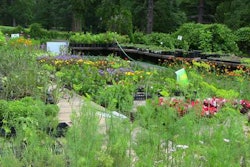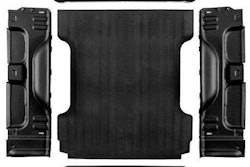 Leicester Cathedral is where the remains of Richard III, discovered in 2012, were buried in a newly constructed tomb earlier this year.
Leicester Cathedral is where the remains of Richard III, discovered in 2012, were buried in a newly constructed tomb earlier this year.Photo: Leicester Cathedral
The Gardens at Leicester Cathedral project was among several British Association of Landscape Industries award winners for 2015. BALI presented the awards at a Dec. 4 ceremony in London.
Leicester Cathedral, where the remains of Richard III were buried in a newly constructed tomb in March of this year, having been discovered in 2012, was honored in BALI’s “Restoration and Regeneration Scheme” category.
“I look out on Cathedral Gardens every day from my front door,” says the dean of the church, David Monteith, in Leicester Cathedral’s news release on the award. “They have given the city an open green space at its very heart, which is already well used by the public all year around, and also sets off our city’s cathedral perfectly.”
 The landscape contractor says the award-winning project was complex and called for a comprehensive renovation of the gardens.
The landscape contractor says the award-winning project was complex and called for a comprehensive renovation of the gardens.Photo: British Association of Landscape Industries
The principal contractor on the project, BALI member P. Casey (Land Reclamation) Ltd of Rochdale, Lancashire, says the project called on the company to “completely regenerate the gardens and surrounding areas of Peacock Lane and the main facades of St. Martin’s House.”
Casey’s operations director, Mike Cafferky, said the Cathedral Gardens restoration was complex, “but, now the work’s complete, the evident quality of the entire project, in keeping with its iconic surroundings, has resulted in this coveted award.”
The project was funded by a government grant valued (in U.S. dollars) at about $3.7 million.
Leicester Cathedral began as St. Martin’s Church, founded by the Normans about 900 years ago. The renovation of its gardens was comprehensive, with new granite-edged, terraced lawns, flower beds and trees planted throughout, along with the addition of hedged garden spaces with several seating areas.
The project was showcased when the remains of Richard III, the last Plantagenet king of England, unearthed near a parking lot in Greyfriars three years ago, were entombed in Leicester Cathedral. Richard died at Bosworth Field in 1485.
Restoration of the gardens included the installation of what P. Casey describes as “major architectural artefacts,” particularly the addition of a Dallas Pierce Quintero sculpture, titled “Towards Stillness,” which was sited near the newly restored bronze statue of Richard III. Special landscape lighting was installed near both works and elsewhere in the gardens.
Minneapolis-based IrriGreen wins 2 Australian patents
IrriGreen Inc. says it has been granted two patents in Australia for the IrriGreen Genius Irrigation System. One patent covers the design and function of the multi-volume spray nozzle, while the second protects the software algorithm that controls the direction, stream distance and rotational speed of IrriGreen sprinkler heads.
 In addition to the Australian patents, IrriGreen says it has several pending in the United States and Europe.
In addition to the Australian patents, IrriGreen says it has several pending in the United States and Europe.Photo: IrriGreen Inc.
Gary Klinefelter, founder and CEO of the Minneapolis-based company, says IrriGreen has several other patents pending in the United States and Europe. Klinefelter’s digital sprinkler system uses technology which the founder adapted from commercial inkjet printers.
The sprinklers are programmed to apply water precisely, Klinefelter says, just as a printer sprays ink on a page in precise patterns. In fact, the company claims its sprinklers can be placed in zones and programmed to follow the shape of a lawn so closely that virtually all water waste is eliminated. The system can be controlled with a mobile phone.
IrriGreen says contractors save time and labor installing its system because instead of rows of four to eight sprinkler heads positioned all around the outside of each zone, IrriGreen systems water from the inside out, with one head in the middle of each zone and no lateral lines. Consequently, IrriGreen systems require fewer heads and less pipe than conventional irrigation systems for comparably sized lawns, the company says.










